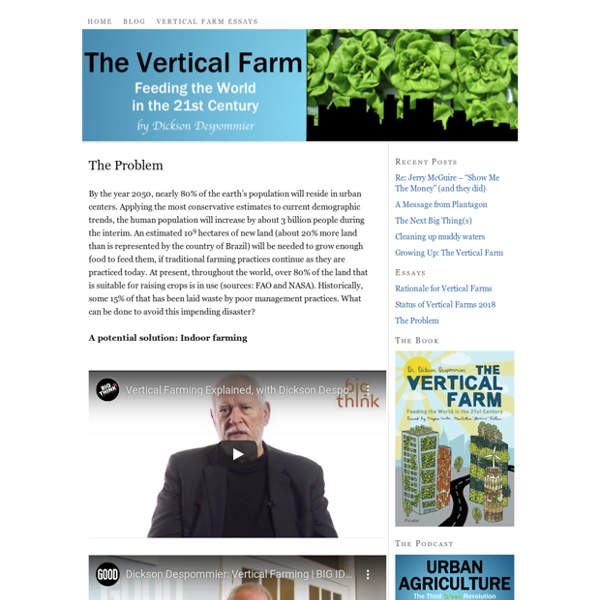



5 Ways Vertical Farms Are Changing the Way We Grow Food No soil? No problem. From Japan to Jackson, Wyoming, plucking fresh lettuce is as easy as looking up. Vertical farms have been sprouting around the world, growing crops in places where traditional agriculture would have been impossible. Vertical farms are multiple stories, often have a hydroponic system and some contain artificial lights to mimic the sun. These green hubs are attractive in a variety of ways since food can be produced with less water (since it just recirculates), creates less waste and takes up less space than traditional farming, ultimately leaving a smaller footprint on the environment.
- City Farms, Parks and Boston: Let’s Grow Up Vertical Farm, photo credited to Valcent via www.economist.com It’s been days since Edward Glaeser published his urban farm-bashing piece in the Boston Globe, but I’m still annoyed. Glaeser, a professor of economics at Harvard University and director of the Rappaport Institute for Greater Boston, managed to argue against farms in a way that could extend to urban parks, gardens, zoos, swimming pools, and most sidewalks. He also ignored some intriguing trends in making urban farming more efficient, a.k.a. the Vertical Farm.
How to build My 50 Dollar Greenhouse First off – you really can build this thing very cheaply, but to do so you have to recycle, freecycle, and scrounge. If you just go out and buy new everything it will probably cost over $200 – still not bad all in all.This Article is featured in Jan 2010 issue of Birds and Blooms Magazine!Want to find out if this thing works before you read all this? Read 6 months in the Greenhouse first.Want to see what happens when a few inches of wet snow accumulates on this? Grow a Living Wall Cool Copper Projects Warm metallic hues are easy to love but often pricey. When you create the look... Easy Doily Bowl Craft a decorative bowl from a doily picked up from a flea market, antique...
Vertical Farms Ruwan FernandoAustralia This design by Australian architect Ruwan Fernando is an open skyscraper with five clusters of u-shaped structures for vertical farming. This project is designed for low-depth water bodies – it uses specialized mechanical filaments for tidal energy production. Indoor Farming Industry Is Growing Fast As experts warn of a coming food crisis, the vertical farming industry aims to create plants that offer more nutritional value and require fewer resources. In vertical farms, plants are grown indoors. Each set of plants is stacked on another. Workers control the climate and closely monitor each plant’s growth. TCLocal: food Archives by Persephone Doliner What Is Processed Food? To process food is to make parts of plants and animals more edible than they would be in their unprocessed state.
Farmers Markets Farmers markets are an integral part of the urban/farm linkage and have continued to rise in popularity, mostly due to the growing consumer interest in obtaining fresh products directly from the farm. Farmers markets allow consumers to have access to locally grown, farm fresh produce, enables farmers the opportunity to develop a personal relationship with their customers, and cultivate consumer loyalty with the farmers who grows the produce. Direct marketing of farm products through farmers markets continues to be an important sales outlet for agricultural producers nationwide. As of National Farmers Market Week, (the first full week in August), there were 8,144 farmers markets listed in USDA’s National Farmers Market Directory.
Plant an Edible Forest Garden Related Content Plant Edible Ground Cover You can sneak a few attractive, low maintenance food plants onto your lawn, and your neighbors will ... Permaculture 2012 Vertical Farming: Can Urban Agriculture Feed a Hungry World? One day, Choi Kyu Hong might find himself in a vegetable garden on the 65th floor of a skyscraper. But, so far, his dream of picking fresh vegetables some 200 meters (655 feet) up has only been realized in hundreds of architectural designs. In real life, the agricultural scientist remains far below such dizzying heights, conducting his work in a nondescript three-story building in the South Korean city of Suwon. The only thing that makes the squat structure stand out is the solar panels on its roof, which provide power for the prototype of a farm Choi is working on.
World's largest Indoor vertical farm to produce greens without sun, soil or water The world's largest, and possibly most sophisticated indoor farm -- where greens grow without sun, soil or water. Well, almost no water. AeroFarms, the company behind the venture, say they will use 95% less water than a conventional outdoor farm. 180° Shift: When Local Means Your Kitchen Blanchet: My name’s Gabe Blanchet, I’m co-founder and CEO at Grove Labs. It’s a pleasure to be here. To start this off I’d like to see a show of hands, how many people in here have grown a plant? A windowsill basil plant all the way to a full-fledged farm? Awesome. How to Grow 100 Pounds of Potatoes in 4 Square Feet On many occasions, we've been tempted to grow our own potatoes. They're fairly low maintenance, can be grown in a pot or in the ground, last a fairly long time if stored properly, and can be very nutritious (high in potassium and vitamin C). Here's more incentive: according to this article, you can grow 100 pounds of potatoes in 4 sq. feet. Learn how after the jump...
Up On The Roof: Vegetables! The bagged organic baby mixed greens on sale in my local Whole Foods Market in Bethesda, MD, are not very “green” at all. To grow the lettuce, vast amounts of water must be moved from the Colorado River to California, the most hydrologically altered landmass on the planet. The lettuce is picked, packaged, washed and shipped in refrigerated trucks (because it’s perishable) roughly 2,800 miles across America. The cost?